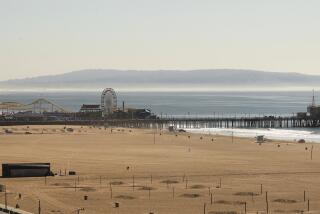Santa Monica Nears Vote on Developer for Airport Project
- Share via
The City of Santa Monica is preparing to take another step along the way to one of its largest development projects: construction on a choice 37-acre parcel at the city’s 68-year-old airport.
The land is being made available for development as the one-runway airport--the oldest in California--reduces the space it occupies and undergoes a $27-million face lift.
The City Council is scheduled to vote Tuesday on a selection committee’s recommendation that Reliance Development Corp., a firm with offices in New York and Los Angeles, be chosen to develop the 37 acres.
The selection committee, made up of members of the city manager’s staff, offered its recommendation this week, choosing Reliance over two other concerns--Watt Investments and a joint venture by Goldrich & Kest and Olympia & York--after stiff competition.
$280-Million Project
If the City Council sustains the recommendation, some details would still have to be worked out, officials said.
But as proposed, Reliance would invest about $280 million to build a 1.27-million-square-foot complex, including offices, a television or movie production studio, shops and a day care center, City Manager John Jalili said.
Santa Monica would receive more than $30 million in lease revenue in the first 10 years of the project. After the 10th year, when construction is expected to be completed, the city would receive about $5.3 million in lease revenue annually, Jalili said.
City officials said they liked the Reliance proposal because it best guaranteed fixed revenue for the city.
“The good thing about the Reliance proposal is they pay us for the land as we release it, whether they start building or not,” said Airport Director Henry Dittmar. “That protects us from the vagaries of the market.”
Under the proposal, Santa Monica would lease the land to the developer for 55 years.
Once the developer is chosen, environmental studies will begin, according to Peggy Curran, director of community and economic development.
Reliance President Henry Lambert said his firm is very excited about the prospect of taking on the project, adding that the land is a prized parcel.
Competition for the project was vigorous, city officials said, with the companies hiring consultants with knowledge of the Santa Monica area. John Alschuler, Santa Monica’s city manager from 1981 to 1984, served as one of Reliance’s advisers.
“This was the Super Bowl of development deals,” said Michael Dieden, owner of a local public relations firm who worked as a consultant for Goldrich & Kest and Olympia & York.
The airport project springs from a 1983 agreement between Santa Monica and the Federal Aviation Administration.
It was agreed that the airport would consolidate its facilities, put a lid on expansion, while “residual land”--37 acres of mostly vacant land south of the airport--would be turned over to development. The total airport area is 215 acres.
“The airport is a gold mine waiting to be tapped,” Santa Monica Mayor James Conn said.
The development and redesign projects “will shrink the airport’s size, making it smaller and more efficient, and develop a cash flow to the city. It is a way to ensure a positive revenue flow to city for the future.”
Development of the 37 acres may spark protest from slow-growth proponents and neighborhood groups that question whether Santa Monica can withstand the additional traffic and sewage that an office park could generate.
“Since it is city-owned, I understand they have more to gain. But we think the quality of life is more important than big bucks,” said Angela de Mott, a member of a Sunset Park neighborhood group.
“As the last, large areas are developed, it is crucial to ask whether the character of Santa Monica can be maintained,” she said.
Duke Kelso, another Sunset Park activist, said a new office park on the residual airport land would dramatically increase the number of commuting cars.
“This speaks to what our future in Santa Monica is going to be,” he said. “We’re going to be buried alive in traffic.”
Meanwhile, the separate projects to update and streamline the airport facilities are already under way.
The $27-million refurbishing, financed with private funds and through the taxing of pilots who use the airport, includes construction of a new terminal and hangar, resurfacing of the runway and taxiways, new lighting and the addition of a restaurant and World War II-vintage aircraft museum, Dittmar said.
Although the size of the airport is being reduced, it will continue to accommodate about 600 airplanes, Dittmar said.
Santa Monica Airport, which has about 180,000 landings and takeoffs a year, is used primarily by businessmen, traffic and news helicopters, pilot training schools and, occasionally, President Reagan, Dittmar said.
For years, airport noise has been a divisive and hotly debated issue.
An 11 p.m. departure curfew is in force, and pilots are being required to reduce noise levels so that no single house in the area is exposed to more than 60 decibels.
Next month, the FAA and airport officials will test a new departure flight pattern designed to dissipate noise, after complaints from Venice residents who say they bear the brunt of airplane noise.
Planes take off southwest over the Penmar golf course. In the test, some will fan out farther to the north, Dittmar said.
He added that the FAA, which is not convinced the plan is the safest measure available, will control the test “rigidly,” using a select group of pilots.
Santa Monica Airport opened in 1919, making it the oldest continually operating airport in the state, Dittmar said. It served as headquarters for Douglas Aircraft starting in the 1920s and through the war years.
More to Read
Sign up for Essential California
The most important California stories and recommendations in your inbox every morning.
You may occasionally receive promotional content from the Los Angeles Times.











